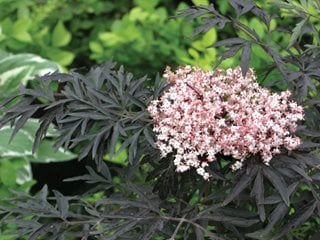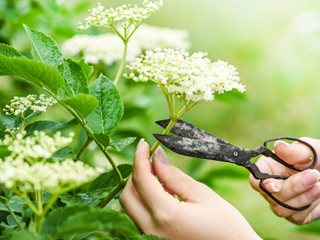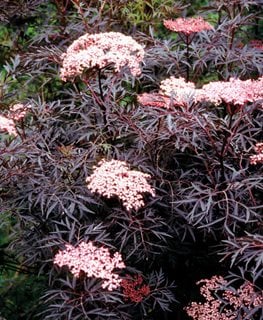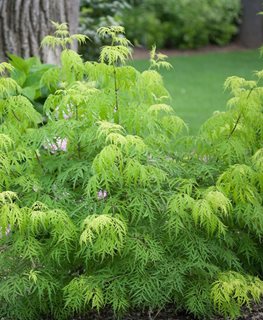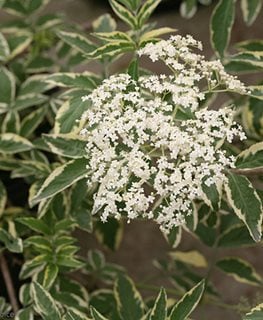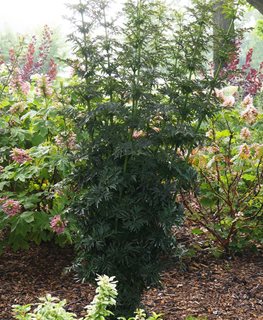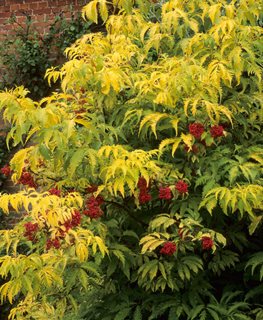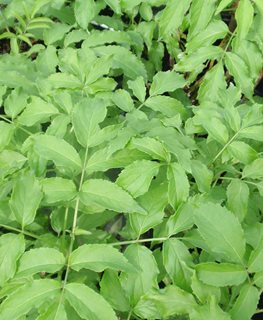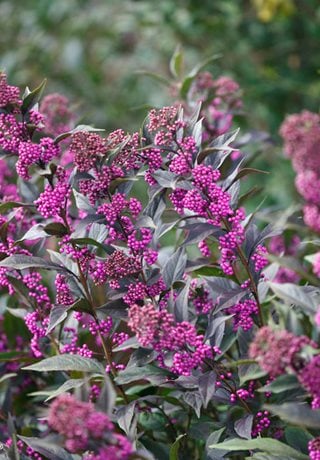Favorite Elderberries for Beautifying the Garden
Don’t just grow elderberries for the edible fruit. These tough and adaptable shrubs can also be surprisingly beautiful landscape plants.Elton John may sing about “feeling fine on elderberry wine,” but the shrub that bears that intoxicating fruit offers many other attributes that gardeners can feel good about.
You may have seen elderberries laden with clusters of dark purple berries growing in the wild along roadsides, woodlands and streambanks, but never considered growing them yourself. “Unfortunately, few people think of the elderberry as an ornamental shrub that would bring beauty to their property,” says Sandy Helsel, of the Herb Society of America. “Today there are numerous cultivars with attractive foliage in green, near black, or yellow and flowers in white, pink, or gold. All can be attractive additions to the garden.”
In addition to their ornamental qualities, they are a valuable contributor to the ecosystem. Providing food and shelter for many species of songbirds and nectar for pollinating insects, elderberries can turn any garden into a beautiful wildlife sanctuary.
On this page: The Basics | Types | Planting and Growing | Pruning Tips | Pictures | Garden Uses
THE BASICS
Botanical name:
Sambucus
Plant Type:
Deciduous shrub, although many people refer to them as elderberry trees.
Hardiness:
Zones 4-9, depending on the species. May survive in colder regions with protection.
Exposure:
Partial to full sun
Bloom time:
Spring and summer
Height:
From 2 feet all the way up to 20 feet, depending on the variety.
Average lifespan:
25 to 50 years
What’s edible:
The flowers and berries have been used for centuries for both culinary and medicinal purposes. The antioxidant-packed berries usually ripen in late summer, between mid-August and mid-September, and can be used to make pies, jams, jellies and wine, and the flowers are often added to cordials and tea (see this recipe for an elderflower cordial).
Toxicity:
Unripe or raw berries and all other parts of the plant are toxic, including the leaves, stems, seeds and roots.
TYPES
Common elderberry (Sambucus canadensis):
Also called “American black elderberry”, this woodland species is native from eastern and central Canada to the southern U.S. It grows to a height of 8 to 12 feet and has large flat-topped clusters of white flowers that emerge in profusion in midsummer, followed by purple-black fruit in late summer and early fall. It spreads by suckers and can be a vigorous grower, so it’s best suited for naturalizing or mass plantings. Zones: 3-9
Black elderberry (Sambucus nigra):
Also called "European elderberry", it is similar to the American variety but often taller (up to 20 feet) and has an earlier bloom season. The cultivars of this species have become popular garden plants, with many featuring smaller growth habits, purple or variegated foliage, and double flowers. Zones: 4-8
Blue elderberry (Sambucus nigra ssp. caerulea):
Sometimes classified as a tree rather than a shrub, this type grows to a height of up to 30 feet. Native to western North America, from Oregon to Baja all the way to western Texas, it thrives in a wide range of climates. Creamy yellow flowers in the spring are followed by dark bluish-purple berries in fall. Zones: 4-9.
Red elderberry (Sambucus racemosa):
A more cold-tolerant species often selected as an ornamental because of its attractive red berries and dense, erosion-preventing root systems. The fruit is less palatable than that of others, but is still very attractive to birds. Grows 8 to 12 feet tall, with a broad, arching form. The fruit often causes stomach upset in many people. Zones: 3-7
Dwarf elderberry (Sambucus ebulus):
In addition to its shorter stature (2 feet tall on average), dwarf elder differs in one important way from others in that it forms very robust underground rhizomes and can quickly produce large colonies. As a garden plant, it is best suited for growing in large containers or in a location where it won’t become invasive. As with red elderberry, the fruit of this type also causes stomach upset in many. Zones: 4-8.
PLANTING AND GROWING
Where to plant:
Grow in full sun in moderately moist, humusy soil. Although they will all tolerate part shade, yellow- and purple-leaved varieties may not develop optimum leaf coloration.
When to plant:
Fall or early spring
How to plant:
Before planting, amend the soil with compost to improve drainage. Although they grow well in moist soil, it shouldn’t be soggy. Space plants 6 to 10 feet apart, depending on the mature size, to allow good air flow between them when fully grown. Though many varieties are self-fruiting, you can encourage higher yields by planting another cultivar of the same species nearby (within 50 to 60 feet) to encourage cross pollination.
General care:
Keep them well watered, especially the first year after planting, because of their shallow roots. To stimulate fruit production, fertilize annually in early spring by applying a granular fertilizer formulated for trees and shrubs.
Propagating:
You can propagate from dormant hardwood cuttings taken in late fall or winter, from softwood cuttings taken in spring or summer, or from root or rhizome cuttings. Although they can be grown from seed, cultivated varieties may not stay true to type.
When to harvest:
Harvest flowers in early spring and the berries when they ripen in late summer or early fall. Unripe berries are toxic and so are their stems, so be sure to remove them before cooking and processing the berries. Typically, they will begin producing fruit two or three years after planting.
Pests:
Generally free of pests, which makes them great shrubs if you want to avoid the use of pesticides.
PRUNING TIPS
Pruning benefits:
Elderberries are very tolerant of pruning, and doing so on a regular basis not only keeps plants dense and more manageable, it can also result in a wonderful display of vibrant foliage. Removing older branches will also result in better fruit production.
When to prune:
In late winter or early spring while the plant is dormant and before leaves start to emerge. You can also prune immediately after flowering if you don’t want your plants to bear fruit.
How to prune:
They bear opposite buds, so prune straight across the branch, above the buds, using a sloping cut. The aim is to reduce the structure down to a low framework and reinvigorate the plant. Also thin out some of the old, congested wood from the center as well as any dead or diseased branches. Regularly removing older branches encourages the growth of new ones that often produce larger, more vibrantly colored leaves.
Removing suckers:
Many types spread by root suckers to form colonies. Prune the suckers as they appear, unless naturalizing is your goal.
ELDERBERRY PICTURES
GARDEN USES
Elderberries make good choices for:
- Wildlife gardens
- Screening
- Back-of-the-border hedge
- Naturalizing
- Rain gardens
- Erosion control
- Understory trees
- Specimen plants
RELATED:
Shrubs 101: A Guide to Growing Shrubs
17 Fast-Growing Shrubs for Your Garden
20+ Rain Garden Plants
10 Ways to Start Building a Garden for Wildlife
10 Shrubs You'll Love
Berries for Year-Round Color
